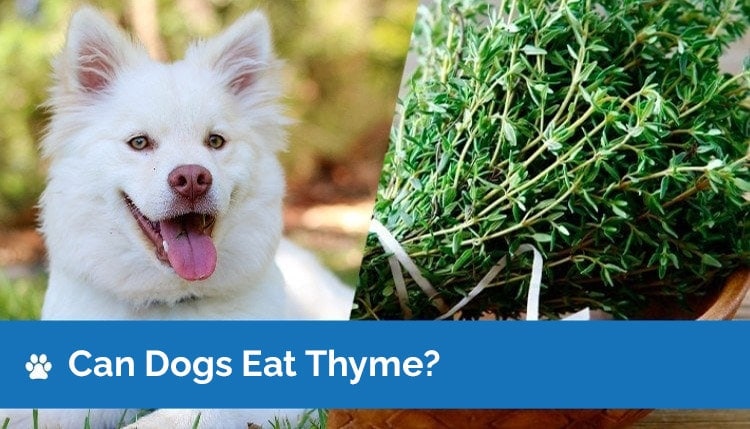Can Dogs Eat Thyme? Is Thyme Safe for Dogs?

Updated on

If you’re like most dog owners, you feed your pet high-quality food from the store. You don’t have time to make their meals from scratch! But you still do want to make sure your pup is getting all the nutrients that they need to thrive as they age. Adding fruits and vegetables to your dog’s meals is a great way to enhance their nutrition intake. You can also include certain herbs from the garden in your pup’s diet to support their optimal health. So, the question is, can dogs eat thyme?
The short answer is a resounding yes! But before filling your pup’s bowl with handfuls of thyme, you should know how this herb will affect them. You should also get a few ideas of how to feed thyme to your dog without them turning up their snout at it. We put together all this important information in this guide!
The Benefits of Thyme for Dogs
Thyme has been used for centuries to benefit the health of humans, and it can be used in many of the same ways to benefit your dog’s health. It is a wonderful antiseptic due to a compound called thymol that it contains, so it can be used to fight off gingivitis.1 The herb can also be used to keep diarrhea at bay.2 In addition, older dogs may find that thyme relieves their arthritic pain.
Thyme may even help lower your dog’s blood pressure, just like it can for us humans.3 Vitamin C is abundant in thyme, which makes it useful for strengthening the immune system. It also contains essential minerals, such as iron and manganese, that your dog needs for a healthy body and mind. These are all great reasons to consider including thyme in your dog’s diet.

Beware of Spanish Thyme
Regular thyme that you find in the grocery store is safe for dogs to consume, but this isn’t the case when it comes to Spanish thyme (otherwise known as Cuban oregano). If your dog gets a hold of Spanish thyme, they could experience side effects like vomiting, diarrhea, and even anorexia. Consuming too much of this herb could even lead to death.
If you think that your dog has eaten Spanish thyme, you should call your local animal poison control center immediately for guidance. Fortunately, Spanish thyme isn’t nearly as common or popular as the thyme that most people have in their kitchens or gardens. So, unless you’re an exotic herb gardener, your dog will likely never even have a chance to consume Spanish thyme.

Feeding Guidelines
Your dog probably won’t experience any serious side effects by eating the entire thyme plant that you are growing in your garden. In fact, if your dog does that, they probably feel like they need it! But they may get an upset belly if they eat too much. Thyme can also slow the clotting of blood, so it could cause problems after a surgical procedure and while your doggy is trying to heal. Therefore, it’s a good idea to avoid thyme altogether for a few days after surgery.
The truth is that your pup doesn’t need much thyme to reap the health rewards that the herb has to offer. Just a pinch of dried thyme or a couple of fresh herb leaves can enhance the flavor of your dog’s meal and help improve their health.
Serving Suggestions
There are all kinds of different ways that you can feed thyme to your pup, whether during mealtime or as part of a snack. Simply sprinkling dried or freshly chopped thyme on your dog’s food should be all it takes to get them to eat it. But if your furry family member doesn’t enjoy their food being mixed with other ingredients, you may have to get a little creative. Try one or more of the following ideas:
- Make Dog Treats — Mix peanut butter, oats, and thyme leaves, then roll the “dough” into little balls. Bake the balls for about 10 minutes at a low temperature to warm and stiffen them. Once cooled, they’ll be ready for your pup to gulp down.
- Share a Smoothie — Add thyme to a banana and berry smoothie, and share it with your pup for a health boost that you can both appreciate.
- Use It to Brush Their Teeth — Since thyme is good for gingivitis, it can be used to brush your dog’s teeth. Just wipe their teeth down with a big sprig of thyme, using the thyme like you would a toothbrush.
- Add Oil to Their Water — You can add a little thyme oil to your dog’s water occasionally as a breath freshener and gum cleaner. If they don’t like the flavor, give them broth with a little thyme oil mixed in.

Final Thoughts
Thyme often makes our meals taste better, and we think that your dog will agree. The herb also offers plenty of health benefits if you’re considering making it a regular part of your dog’s diet. You shouldn’t have a problem getting your dog to eat a little dried or fresh thyme mixed in with their dog food.
But it’s not the end of the world if your pup doesn’t enjoy eating this herb. It’s not a cure-all tonic that they can’t live without. So, don’t force the issue if you find that the herb gets rejected.
See Also:
Featured Image Credit: Olha Afanasieva, Shutterstock











